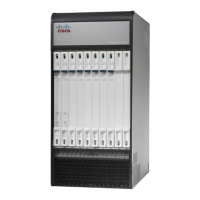• 10GBase-SR – connects the port to a multi-mode fiber optic cable over relatively short distances (30.80
meters).
• 10GBase-LR – connects the port to a single-mode fiber optic cable over a maximum distance of 10km.
The table below lists the signaling parameters supported for the above transceiver types.
Table 13: SFP+ Transceiver Parameters
ValueParameterSFP+ Transceiver Type
-1.0dBmMaximum transmit level10GBase-SR
-7.3dBmMinimum transmit level
-1.0 dBm (saturation average power)Maximum receive level
-11.1 (sensitivity average power)Minimum receive level
0.5 dBmMaximum transmit level10GBase-LR
-8.2 dBmMinimum transmit level
0.5 dBm (saturation average power)Maximum receive level
-12.6 (sensitivity average power)Minimum receive level
Fiber Optic Bend Radius Guidelines
When a fiber cable is bent excessively, the optical signal within the cable may refract and escape through the
fiber cladding. Bending can also permanently damage the fiber by causing micro cracks, especially during
cable installation due to pulling forces. The result is known as bend loss: a loss of signal strength that may
compromise the integrity of the data transmission.
To avoid damaging the fiber optic cable, the cable connector, or the optical interface, do not install or
remove fiber optic transceivers with fiber-optic cables attached. Disconnect all cables before removing
or installing a transceiver.
Caution
Recommended Bend Radius
ANSI/TIA/EIA-568B.3, "Optical Fiber Cabling Components Standard," specifies minimum bend radius
standards and maximum pulling tensions for 50/125-micron and 62.5/125-micron fiber-optic cables. Those
recommendations include:
•
1 inch (2.54cm) under no pull load.
•
2 inches (5.08cm) when subject to tensile loading up to the rated limit.
For inside plant cable other than two- and four-fiber, the standard specifies:
ASR 5500 Installation Guide
68
MIO Port Cabling
Fiber Optic Bend Radius Guidelines

